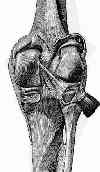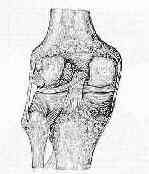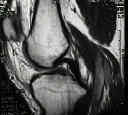 - Anatomy:
- Anatomy: - PCL is approximately twice as strong and twice as thick as the normal ACL (therefore less commonly injured);
- size: 13 mm, its length, 38 mm, (approximates that of ACL);
- origin:
- PCL originates from the antero-lateral aspect of medial femoral condyle in the area of intercondylar notch;
- it origin is much more anterior than that of ACL;
- ref: Topography of the Femoral Attachment of the Posterior Cruciate Ligament
- insetion:
- tibial atatchment is not intra articular, but over back of tibial platuea, it is approximately 1 cm distal to the joint line;
- Tibial Insertion of the Posterior Cruciate Ligament: A Sagittal Plane Analysis Using Gross, Histologic, and Radiographic Methods
- Morphology of the Tibial Insertion of the Posterior Cruciate Ligament
- subdivisions:
- ligament can be partially separated into an anterolateral and posteromedial;
- anterolateral bundle:
- represents about 65% of the substance of the PCL;
- in flexion the anterolateral band is tight and the posteromedial band is lax;
- most surgeons seek to reconstruction the anterolateral portion of the PCL noting its larger size and more important functional role;
- posteromedial bundle:
- comprimises 35% of the PCL;
- in extension the anterolateral band is lax and posteromedial band is tight;
- ref: Changes in knee laxity and ligament force after sectioning the posteromedial bundle of the posterior cruciate ligament.
- ligaments of Humphrey and Wrisberg:
- major blood supply: from middle genicular artery;
- nerve supply: tibial nerve (significant mechanoreceptors)
- function and natural history:
- provides 95% of total restraining force to straight posterior translation of the tibia relative to femur;
- secondary restraints to posterior displacement of the tibia include posterolateral capsule, popliteus, MCL, and POL;
- secondary action includes resistance to varus, valgus, and external rotation;
- PCL is more verticle in extension and more horizontal in flexion;
- hyperflexion mechanism: most common mechanism for an isolated PCL injury:
- hyperflexion causes the large anterolateral component to fail but spares the posteromedial band (which is loose in flexion);
- this type injury does not involve the secondary restraints and does well with non operative treatment;
- dashboard injury (from MVA): may result in severe combined injuries;
- left untreated PCL ruptures may lead to chronic patello femoral as well as medial compartment arthrosis;
- references:
- Epidemiology of posterior cruciate ligament injuries.
- Effect of Posterior Cruciate Ligament Deficiency on In Vivo Translation and Rotation of the Knee During Weightbearing Flexion
- A clinically relevant assessment of posterior cruciate ligament and posterolateral corner injuries. Evaluation of isolated and combined deficiency.
- Effects of knee flexion angle and loading conditions on the end-to-end distance of the posterior cruciate ligament: a comparison of the roles of the anterolateral and posteromedial bundles.
Current Concepts Review. Injuries of the Posterior Cruciate Ligament.
The results of surgical repair of acute tears of the posterior cruciate ligament.
Bone-block transfer of the medial head of the gastrocnemius for posterior cruciate insufficiency.
Acute tears of the posterior cruciate ligament. Results of operative treatment.
Posterior tibial subluxation of the posterior cruciate-deficient knee.
Long-term followup of posterior cruciate ligament rupture: a study of 116 cases.
Isolated posterior cruciate ligament injuries in athletes.
The Attachments of the Fiber Bundles of the Posterior Cruciate Ligament: An Anatomic Study.
Anatomy of the posterior cruciate ligament. A review.
Posterior Cruciate Ligament. A Demonstration in Six Patients and a Study of Anatomical Specimens.
Force displacement characteristics of the posterior cruciate ligament.
Strain measurement of the human posterior cruciate ligament. SW Arms et al. Trans Orthop. Res. Soc. Vol 9. 1984. p 355.
The cruciate ligaments of the knee joint. Anatomical, functional and experimental analysis.
Simultaneous measurement of changes in length of the cruciate ligaments during knee motion.
Function of Posterior Cruciate Ligament Bundles During In Vivo Knee Flexion
Arthroscopically Pertinent Anatomy of the Anterolateral and Posteromedial Bundles of the Posterior Cruciate Ligament

Original Text by Clifford R. Wheeless, III, MD.
Last updated by Data Trace Staff on Tuesday, October 13, 2015 7:25 am


